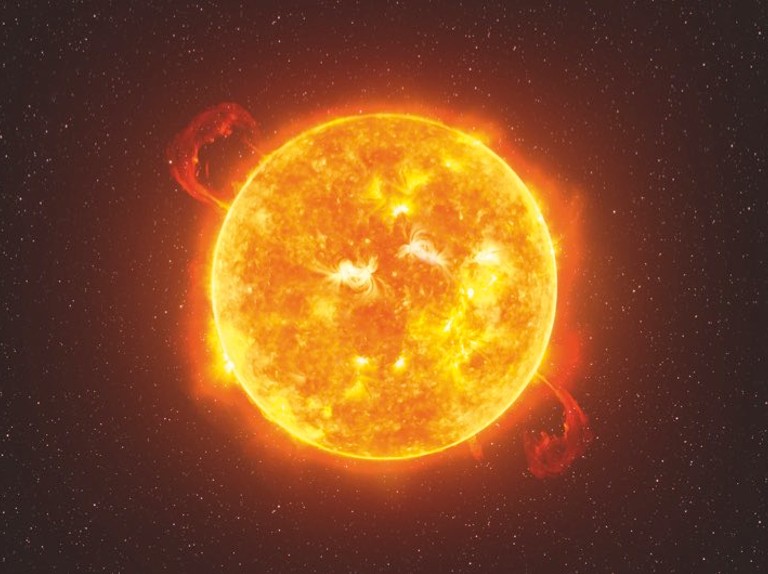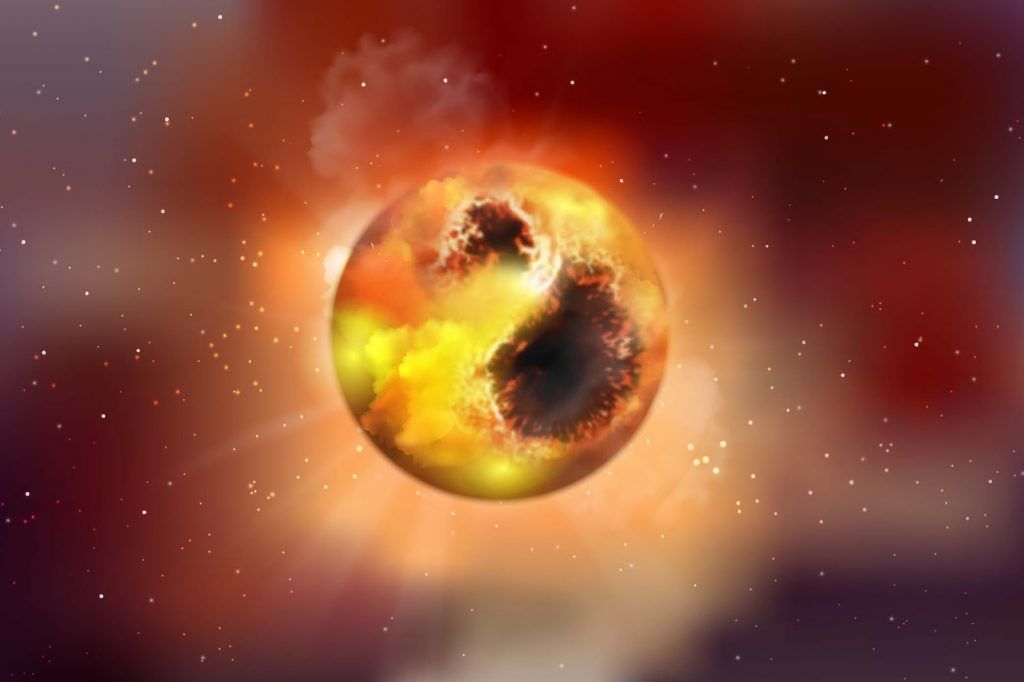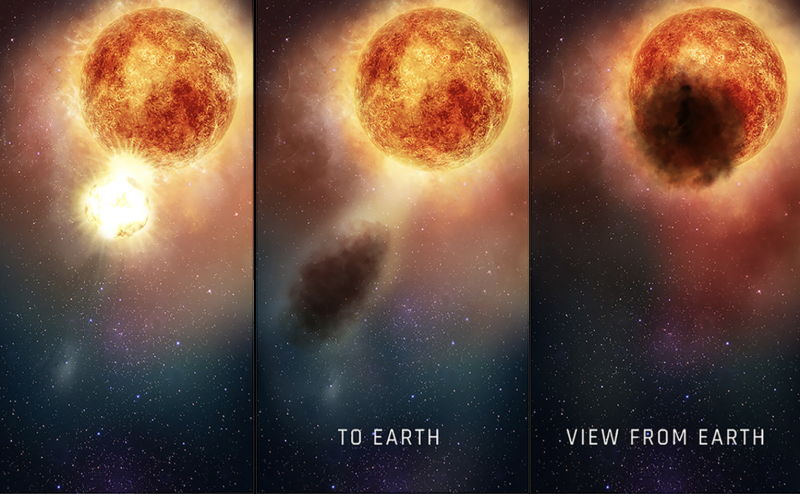Betelgeuse is usually the ninth brightest star in the night sky, and since it brightness varies, it is sometimes the second or the first brightest star in the constellation of Orion.
Key Facts & Summary
- Betelgeuse is a red supergiant star that is located at around 548 light-years / 168 parsecs away from the Sun.
- It is among the biggest stars ever discovered and among the most luminous.
- Betelgeuse is 126,000 times more luminous than our Sun.
- It is also more massive, having 16.5 solar masses and a whooping 764 solar radii.
- This means that Betelgeuse is more than 1200 times bigger than our Sun.
- Big stars don’t necessarily mean hot stars, and Betelgeuse has a surface average temperature of only 3,600 K.
- This means it is much more colder than our Sun.
- Betelgeuse is significantly younger than our Sun, being only eight million years old.
- Betelgeuse sometimes outshines the brightest star in Orion, Rigel.
- It is a semiregular variable star, and its apparent magnitude varies from +0.0 to +1.23.
- This makes Betelgeuse have the broadest range of varying magnitude/brightness out of any star.
- Betelgeuse is surrounded by a nebula, which is 250 times its size.
- This nebula extends up to 20.000 AU away from the star. One AU is the distance between Earth and the Sun!
- This nebula actually formed out of Betelgeuse’s lost mass. The star loses around one solar mass every 10,000 years.
- Betelgeuse is the first star to have its photosphere measured.
- This star moves at a speed of 30 km / 18.6 mi per second.
- Betelgeuse is part of two asterisms, namely, the Winter Triangle asterism and the Winter Hexagon asterism.
- Betelgeuse is designated as Alpha Orionis.
Betelgeuse is among the biggest stars ever discovered by astronomers. It is the second brightest star located in the constellation of Orion, the celestial hunter, but since its brightness varies, it often becomes the brightest star in its constellation, outshining Rigel.

Betelgeuse is a red supergiant star and its name comes from Arabic, translating to “the arm of the giant,” reffering to Betelgeuses’s position in the constellation, marking Orion’s celestial arm.
Betelgeuse Characteristics
Betelgeuse is a red supergiant star of spectral type M1-M2 la-ab. It has exhausted its hydrogen supplies, and in the near future, it will explode as a supernova.
It is a semiregular variable type of star, having brightness variations from magnitude +0.0 to +1.23. It is between 90,000 and 126,000 times more luminous than our Sun; however, much of its light is in the invisible part of the spectrum.

Betelgeuse has a surface average temperature of only 3,600 K, colder than our Sun, and it is surrounded by a nebula, which is 250 times its size.
This nebula extends up to 20.000 AU away from the star. One AU is the distance between Earth and the Sun! The nebula actually formed out of Betelgeuse’s lost mass. The star loses around one solar mass every 10,000 years. It basically consumes one Sun every 10,000 years.
Betelgeuse travels through space at supersonic speeds, reaching 30 km / 18.6 mi per second. Its stellar wind creates a bow shock.
Formation
Betelgeuse is very young in comparison to our Sun, being only eight million years old. Many believe that Betelgeuse evolved from an O-type main-sequence star.
This star formed out of a very rich insterstellar medium of gas and dust, hence its short lifespan – it will explode as a supernova in the near future – gravity pulled the swirling dust and gas together and formed the giant star Betelgeuse.
Fun Kids Facts For Haumea the Dwarf Planet
- You can see Betelgeuse in January if you look in the east just after sunset.
- People from all around the world can see Betelgeuse, however, from Antarctica, it isn’t visible. The best time to observe Betelgeuse is in December.
- Only 13% of Betelgeuse’s energy is emitted in visible light.
- Betelgeuse bears many names. In was known even as Bahu, in Sanskrit – which means running antelope or stag.
- Long ago, some ancient clans from Japan, namely Taira, and Heike, adopted Betelgeuse and its red color as their symbol.
- You wouldn’t want Betelgeuse to replace our Sun. It would reach the orbit of Jupiter! Thus, Betelgeuse would eat us completely.
Size and Comparison
Betelgeuse is among the biggest stars in the Universe, having 16.5 solar masses and a whooping 764 solar radii. This means that Betelgeuse is over 1,400 times bigger than our Sun in diameter!

Trivia
Did the Star Betelgeuse Exlode?
Betelgeuse didn’t explode yet, but it certainly will in the near future. It is a very unstable star due to its collosal size. When Betelgeuse will explode, it will probably turn into a black hole.

How Long Does Betelgeuse Have Left?
Betelgeuse became a red supergiant for over 40,000 years already. It will explode anytime in the next million years. This event will be witnessed even from Earth.
What is Happening to the Star Betelgeuse?
Betelgeuse is a semiregular variable star, and sometimes, its dimming or shining rapidly. This has led many to believe that the star is approaching the end of its life.
It indeed is, however, this won’t happen so soon. If Betelgeuse is dimming, or brightening, it is actually a natural process and nothing to be scared of.
Will Betelgeuse Affect Earth?
Betelgeuse is located at over 548 light-years / 168 parsecs away from the Sun. When it explodes as a supernova, we will indeed witness a bright spot of light, but the star is too far away to affect us in any way, shape, or form.
Betelgeuse Star Notes
- Betelgeuse is a red supergiant star, and it is among the biggest stars in the Universe.
- It is a very unstable star, and it is very possible that we will witness its supernova explosion in the near future.
- Betelgeuse is the second brightest star in the constellation of Orion, the celestial hunter.
- Since Betelgeuse varies in brightness, it sometimes becomes even brighter than Rigel, the brightest star in its constellation.
- Betelgeuse is more than 1,000 times bigger than our Sun, and more than 90,000 times brighter.
- Most of Betelgeuse’s light isn’t visible to us, since it is in the invisible part of the light spectrum.
- Betelgeuse has the broadest range of varying magnitude/brightness out of any star.
- Betelgeuse is surrounded by a nebula, which is 250 times its size. This nebula extends up to 20.000 AU away from the star, and it formed out of Betelgeuse’s lost mass. The star loses around one solar mass every 10,000 years.
- Betelgeuse is the first star to have its photosphere measured.
- This star moves at a speed of 30 km / 18.6 mi per second.
- Betelgeuse is part of two asterisms, namely, the Winter Triangle asterism and the Winter Hexagon asterism.
- Betelgeuse is designated as Alpha Orionis.
- Betelgeuse is generally the ninth brightest star in the night sky.
Sources:
Image Sources:
- https://images.immediate.co.uk/production/volatile/sites/4/2020/02/GettyImages-1198303044-3583e97.jpg?quality=90&resize=768,574
- https://cdn.mos.cms.futurecdn.net/8MWSnXYYzDdPh9s6nwcuAW-1200-80.jpg
- https://i.pinimg.com/originals/c7/2a/32/c72a32a8677d9745041a3f063960b3e4.jpg
- https://earthsky.org/upl/2020/08/betelgeuse-dimming-explained-artist-cp-high-res-e1597524199975.png
